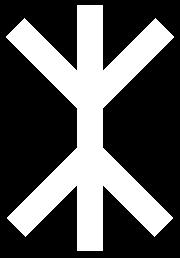
Wendehorn
Encyclopedia

Guido von List
Guido Karl Anton List, better known as Guido von List was an Austrian/German poet, journalist, writer, businessman and dealer of leather goods, mountaineer, hiker, dramatist, playwright, and rower, but was most notable as an occultist and völkisch author who is seen as one of the most important...
's Das Geheimnis der Runen
Das Geheimnis der Runen
Das Geheimnis der Runen is a book by Austrian mystic Guido von List, in which he presents his "Armanen Futharkh".It appeared as a periodical article in 1906, and as a standalone publication in 1908.-Contents:...
, where it does not figure as a full member of the Armanen runes
Armanen runes
The Armanen runes, or Armanen 'Futharkh' as Guido von List referred to them, are a row of 18 runes that are closely based in shape on the Younger Futhark...
, but is mentioned in the context of the crescent moon being "the rune of Freya
Freya
In Norse mythology, Freyja is a goddess associated with love, beauty, fertility, gold, seiðr, war, and death. Freyja is the owner of the necklace Brísingamen, rides a chariot driven by two cats, owns the boar Hildisvíni, possesses a cloak of falcon feathers, and, by her husband Óðr, is the mother...
, who promotes childbirth."
It was taken up by List's Armanist followers, such as Rudolf John Gorsleben
Rudolf John Gorsleben
Rudolf John Gorsleben was a German Ariosophist, Armanist , journal editor and playwright.-Life:...
, and Siegfried Adolf Kummer
Siegfried Adolf Kummer
Siegfried Adolf Kummer was a German mystic and Germanic revivalist. He is also most well known for his revivalism and use of the Armanen runes row...
and is still in use in Irminenschaft
Irminenschaft
Irminenschaft is a current of Ariosophy based on a Germanic deity Irmin which is supposedly reconstructed from literaric, linguistic and oonomastic sources...
and Armanenschaft-inspired esotericism today (Karl Spiesberger
Karl Spiesberger
Karl Spiesberger was a German mystic, occultist, Germanic revivalist and Runosophist. He is most well known for his revivalism and usage of the Sidereal Pendulum for divination and dowsing and for his anti-racialist stance and revivalist usage of the Armanen Futharkh runic system after the second...
, Karl Hans Welz, Adolf Schleipfer, Larry E. Camp).
Karl Maria Wiligut
Karl Maria Wiligut
Karl Maria Wiligut was an Austrian Ariosophist- Biography :...
utilised this symbol, referring to it as 'Wend-horn', in his own runic row
Wiligut runes
The Wiligut runes are a runic row developed by Karl Maria Wiligut in 1934. Wiligut rejected Guido von List's Armanen runes and his overall philosophy.Wiligut claimed to have been initiated into "runic lore" by his grandfather Karl Wiligut ....
but did not develop his runic row until 1934 and the Wendehorn is mentioned in List
Guido von List
Guido Karl Anton List, better known as Guido von List was an Austrian/German poet, journalist, writer, businessman and dealer of leather goods, mountaineer, hiker, dramatist, playwright, and rower, but was most notable as an occultist and völkisch author who is seen as one of the most important...
1908, Gorsleben
Rudolf John Gorsleben
Rudolf John Gorsleben was a German Ariosophist, Armanist , journal editor and playwright.-Life:...
1930 and Kummer
Siegfried Adolf Kummer
Siegfried Adolf Kummer was a German mystic and Germanic revivalist. He is also most well known for his revivalism and use of the Armanen runes row...
1932. Its earliest reference in contemporary times is in the many works of Guido von List, of which many are published before 1908.
Karl Spießberger
Karl Spiesberger
Karl Spiesberger was a German mystic, occultist, Germanic revivalist and Runosophist. He is most well known for his revivalism and usage of the Sidereal Pendulum for divination and dowsing and for his anti-racialist stance and revivalist usage of the Armanen Futharkh runic system after the second...
in his 1955 Runenmagie identified it as a combination of "male Man" and "female Yr", symbolizing a hierosgamos.
The Wendehorn appears in "runic massage".
The Wendehorn shape is shown in the logo of the band Belborn
Belborn
Belborn was the neofolk, experimental and traditional music works of German musicians Holger F. Belborn was the neofolk, experimental and traditional music works of German musicians Holger F. Belborn was the neofolk, experimental and traditional music works of German musicians Holger F. (Holger...
.
See also
- Guido von ListGuido von ListGuido Karl Anton List, better known as Guido von List was an Austrian/German poet, journalist, writer, businessman and dealer of leather goods, mountaineer, hiker, dramatist, playwright, and rower, but was most notable as an occultist and völkisch author who is seen as one of the most important...
- Karl SpiesbergerKarl SpiesbergerKarl Spiesberger was a German mystic, occultist, Germanic revivalist and Runosophist. He is most well known for his revivalism and usage of the Sidereal Pendulum for divination and dowsing and for his anti-racialist stance and revivalist usage of the Armanen Futharkh runic system after the second...
- Rudolf John GorslebenRudolf John GorslebenRudolf John Gorsleben was a German Ariosophist, Armanist , journal editor and playwright.-Life:...
- Siegfried Adolf KummerSiegfried Adolf KummerSiegfried Adolf Kummer was a German mystic and Germanic revivalist. He is also most well known for his revivalism and use of the Armanen runes row...
- Armanen runesArmanen runesThe Armanen runes, or Armanen 'Futharkh' as Guido von List referred to them, are a row of 18 runes that are closely based in shape on the Younger Futhark...
- HagalHagalHagal may refer to:*The Old High German for "hail"*Hagall, the Younger Futhark h rune*Hagal , the derived rune in Germanic mysticism*Hagal , a fictional planet in Frank Herbert's Dune universe...
- Stephen E. Flowers
- Jarl Widar

